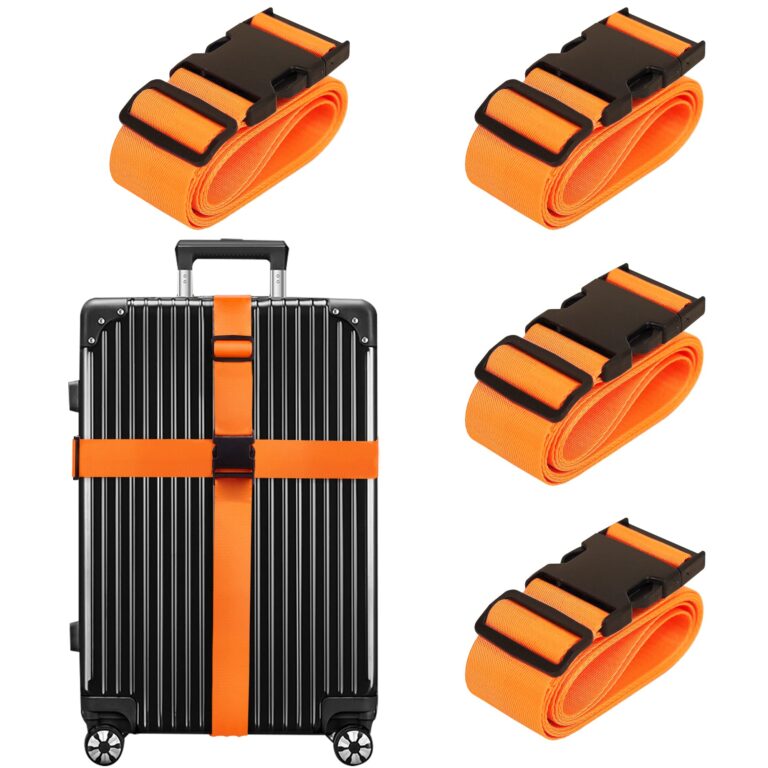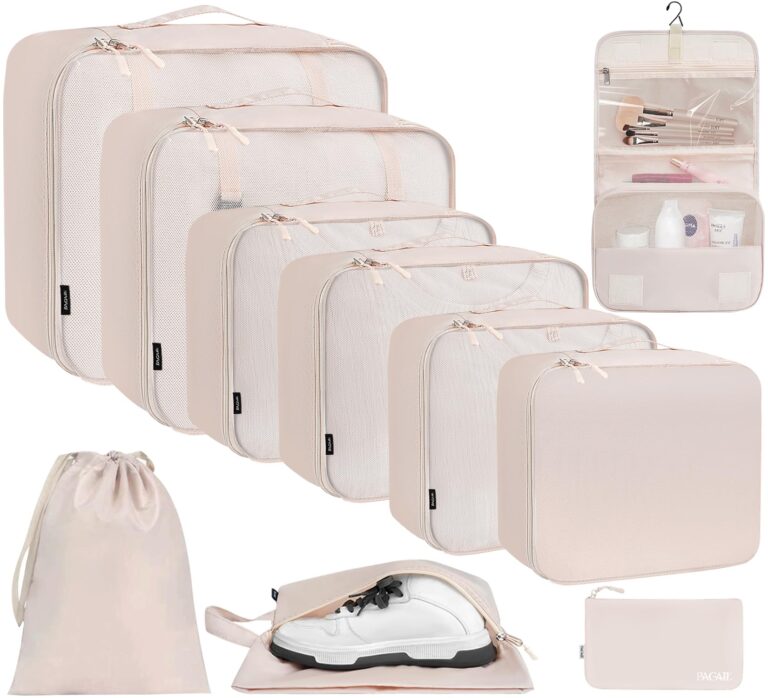Solar chargers harness sunlight to power up devices, making them a popular choice for outdoor activities like backpacking. They offer a way to recharge gadgets without relying on electrical outlets, which is handy when you’re far from civilization.
Their portability and ability to use renewable energy make them appealing for those who want to stay connected while minimizing their gear.
When it comes to backpacking, solar chargers need to strike a balance between size, weight, and power output. They should be compact enough to carry easily but powerful enough to charge phones, GPS units, or cameras efficiently.
Durability and weather resistance are also important since backpacking often involves variable conditions.
The critical factors to consider are panel type, charging speed, and how well the charger integrates with your gear. Some models come with built-in batteries for energy storage, while others rely solely on direct sunlight.
We spent time comparing setups that fit well into a backpack and deliver reliable power for outdoor use.
Best Solar Chargers for Backpacking
We’ve put together a list of solar chargers that are perfect for backpacking trips. These picks are lightweight, durable, and efficient to keep your devices powered while you’re out in nature.
Let’s check out the best options for your next adventure.
BigBlue 28W Solar Charger
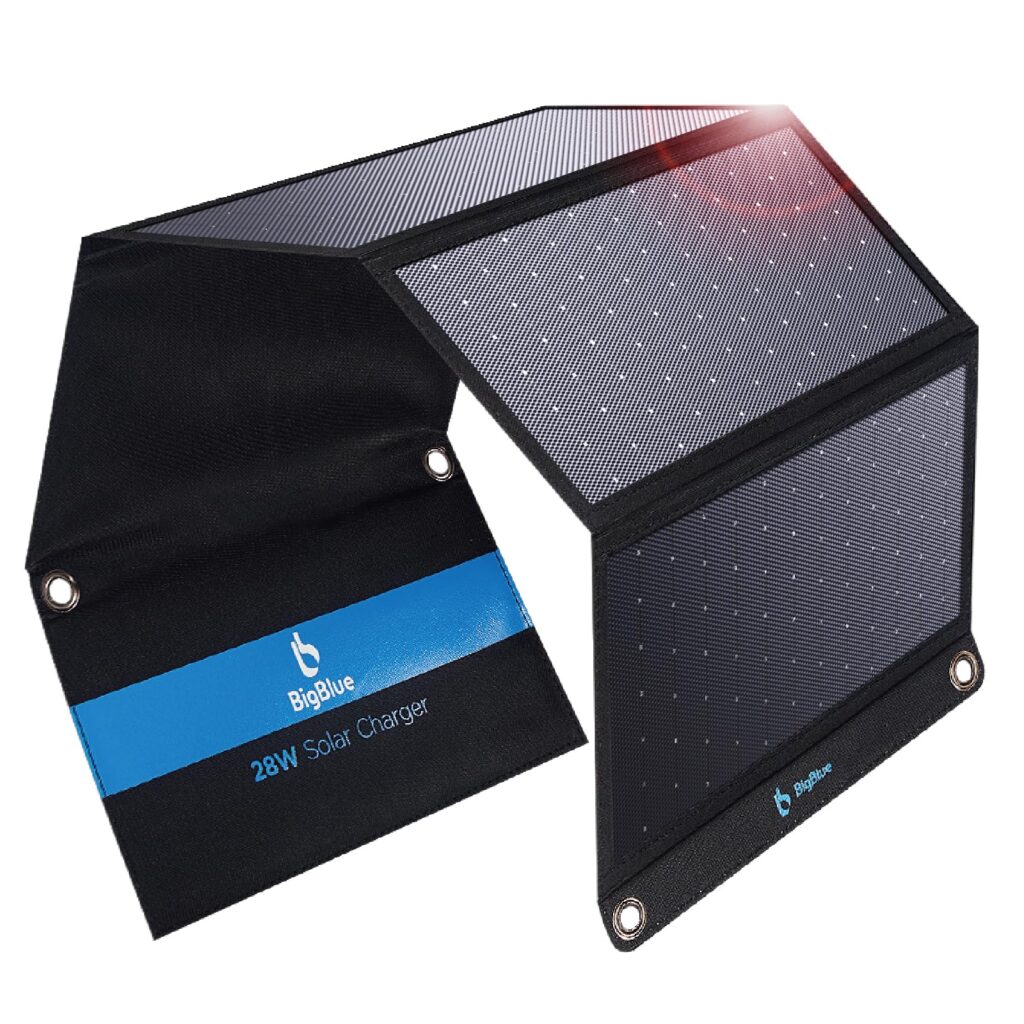
We found this solar charger a solid choice for backpackers who want a compact, efficient way to top off devices on the trail.
Pros
- Multiple USB ports let us charge several gadgets at the same time.
- The panel stays pretty efficient even in cloudy or low-light conditions.
- Lightweight and folds up small, so it doesn’t take much space in our packs.
Cons
- It doesn’t store power, so it only works while in direct sunlight.
- The USB junction box isn’t fully waterproof, which means you have to be careful in wet weather.
- Charging speeds vary a lot depending on sun intensity and angle.
While using this on hikes, we appreciated how easy it was to unfold and clip onto our backpack. The surface seemed to absorb sunlight better than other chargers we’ve tried.
We also liked charging multiple devices simultaneously without needing extra adapters. It worked best when we faced it directly towards the sun, but the low-light efficiency saved us on dull days.
It’s not perfect though—because it doesn’t have a built-in battery, you need to keep your devices plugged in during charging. The junction box needs protection from rain.
Mregb Solar Power Bank 42800mAh
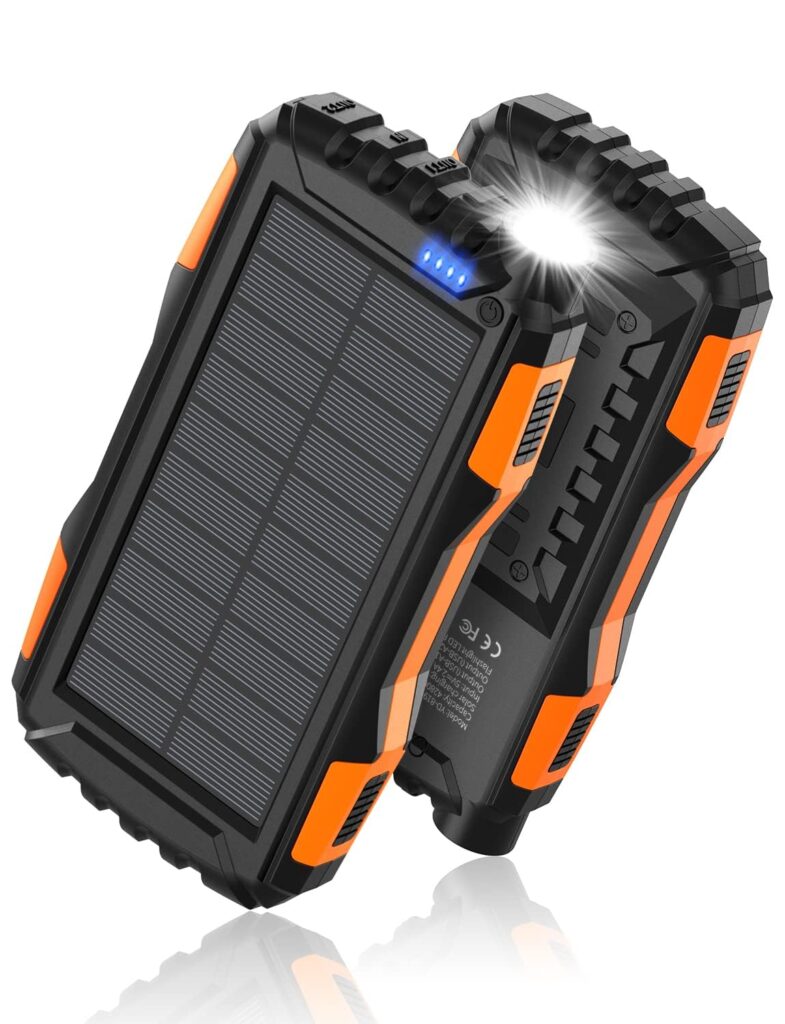
If you want a tough, high-capacity solar charger that works well for emergencies, this is worth considering.
Pros
- Built to handle rough outdoor conditions with water and drop resistance
- Huge battery capacity keeps devices powered for days
- Bright built-in flashlight is genuinely useful at night
Cons
- Solar charging is slow, best used as backup power
- The device feels a bit heavy to carry on long hikes
- USB-C charging port has a risk of breaking
We found the Mregb Power Bank solid for trips where rough handling and weather are expected. Its durable shell made it easy to stash in a backpack without worrying about damage.
The IP67 rating gave us peace of mind around water or dust. The huge 42800mAh battery means we could keep charging our phones and tablets multiple times during multi-day outings.
The flashlight was a handy bonus after dark, much brighter than we expected from a power bank. Solar recharging worked, but only slowly.
It’s best to think of this as a backup that tops off power in a pinch, not a primary charging method. It’s also a little heavy to carry all day, so planning usage around that helps.
The USB-C port was an issue for one of us after some use, so handle it gently.
BLAVOR Solar Charger 10,000mAh
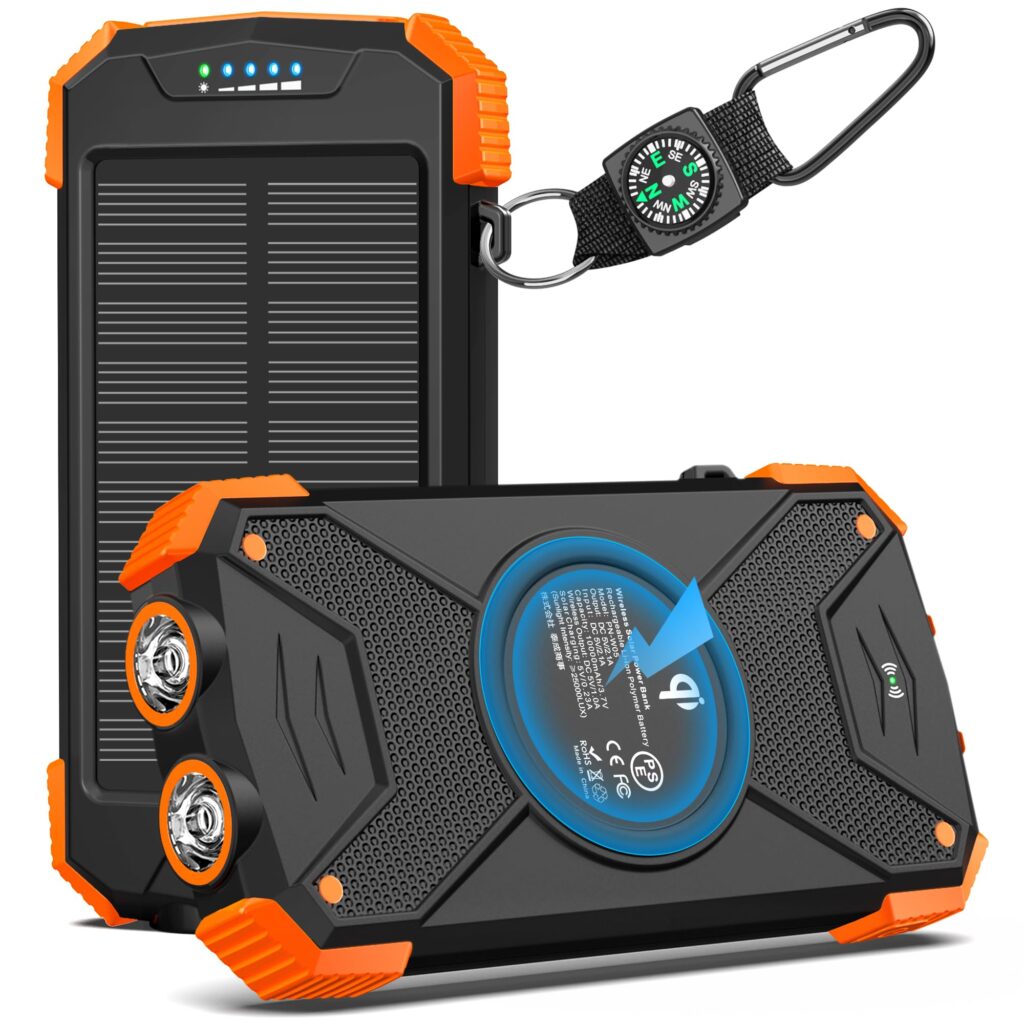
This solar charger is a solid choice for backpackers who want a compact, reliable power bank with fast charging and handy outdoor features.
Pros
- Fast USB-C charging that doesn’t overheat your devices
- Durable, weather-resistant design for tough outdoor use
- Wireless charging and built-in flashlight add convenience on the trail
Cons
- Solar panel mainly offers slow, trickle charging in real conditions
- Slightly heavier than some other ultra-light units
- Wireless charging can be slower compared to wired
We found the BLAVOR solar charger well built and definitely tough enough for backpacking trips. Its rubberized coating and waterproof rating make it feel secure when clipped to a pack, even in rough weather.
Charging our phone from zero to halfway in around 30 minutes with USB-C was impressive. Wireless charging worked well for overnight top-ups but wasn’t super fast.
The solar panel itself was helpful as an emergency option but didn’t provide a meaningful charge during a day hike. The dual flashlight is a nice bonus for campsite tasks or navigating in the dark.
Though the unit is a bit heavier than ultra-light models, it made up for that with convenient features we actually used.
Hiluckey Solar Charger
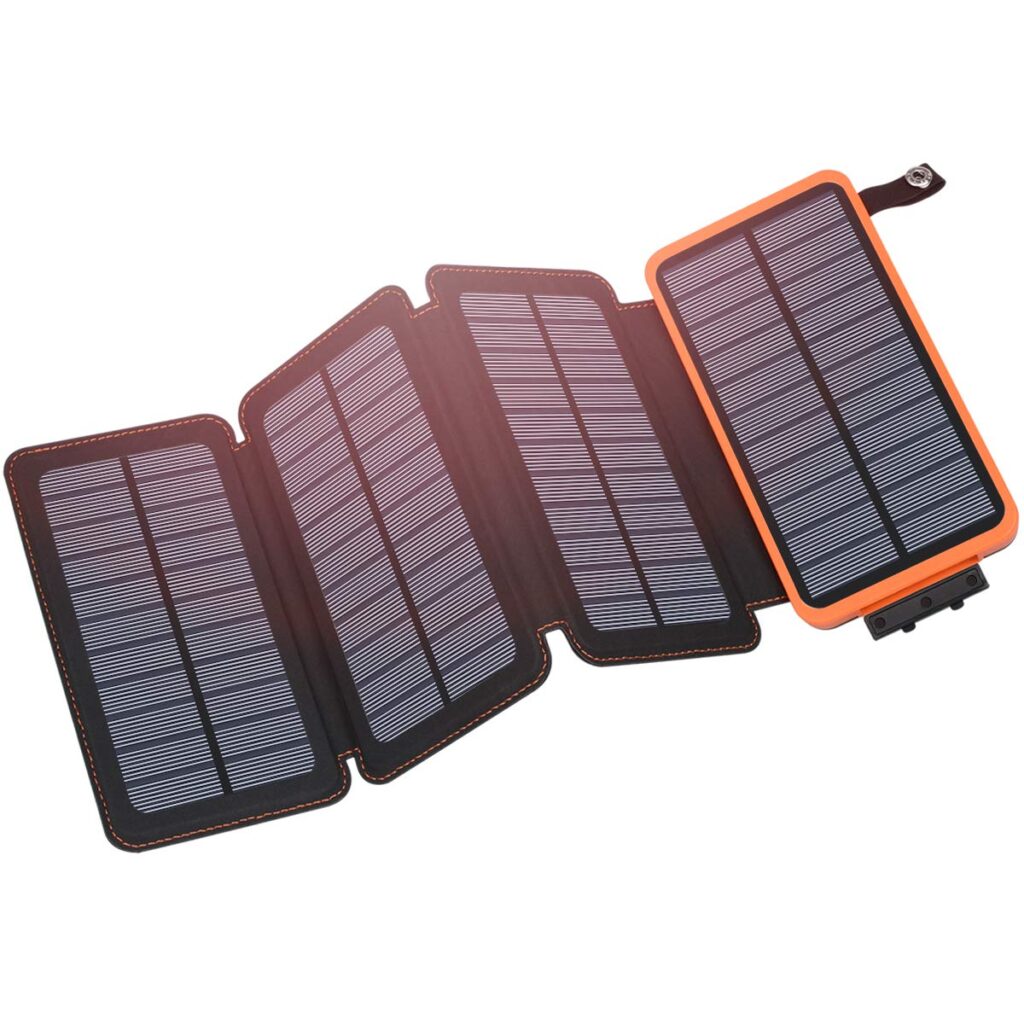
This charger is a solid pick if you want a high-capacity power bank that also offers quick charging and can survive outdoor use.
Pros
- Charges devices fast with QC 3.0 technology
- Large battery holds multiple charges for phones and tablets
- Durable design with built-in flashlight for camping
Cons
- Solar charging is very slow and not reliable alone
- No built-in hook to hang directly on a backpack
- Heavy for ultralight backpacking trips
We found the Hiluckey charger impressive for its battery size and quick USB charging. It easily powered our phones multiple times on long hikes, which is a real convenience when access to outlets is limited.
The rugged build and bright flashlight felt like nice bonuses for backpacking and emergency use. However, the solar panels on this model didn’t provide much help unless the bank already had charge.
Also, the lack of an integrated hanging clip meant we had to get creative attaching it to our pack. Its weight is noticeable, so consider if you need something lighter for longer treks.
Sudrov Solar Charger 42800mAh
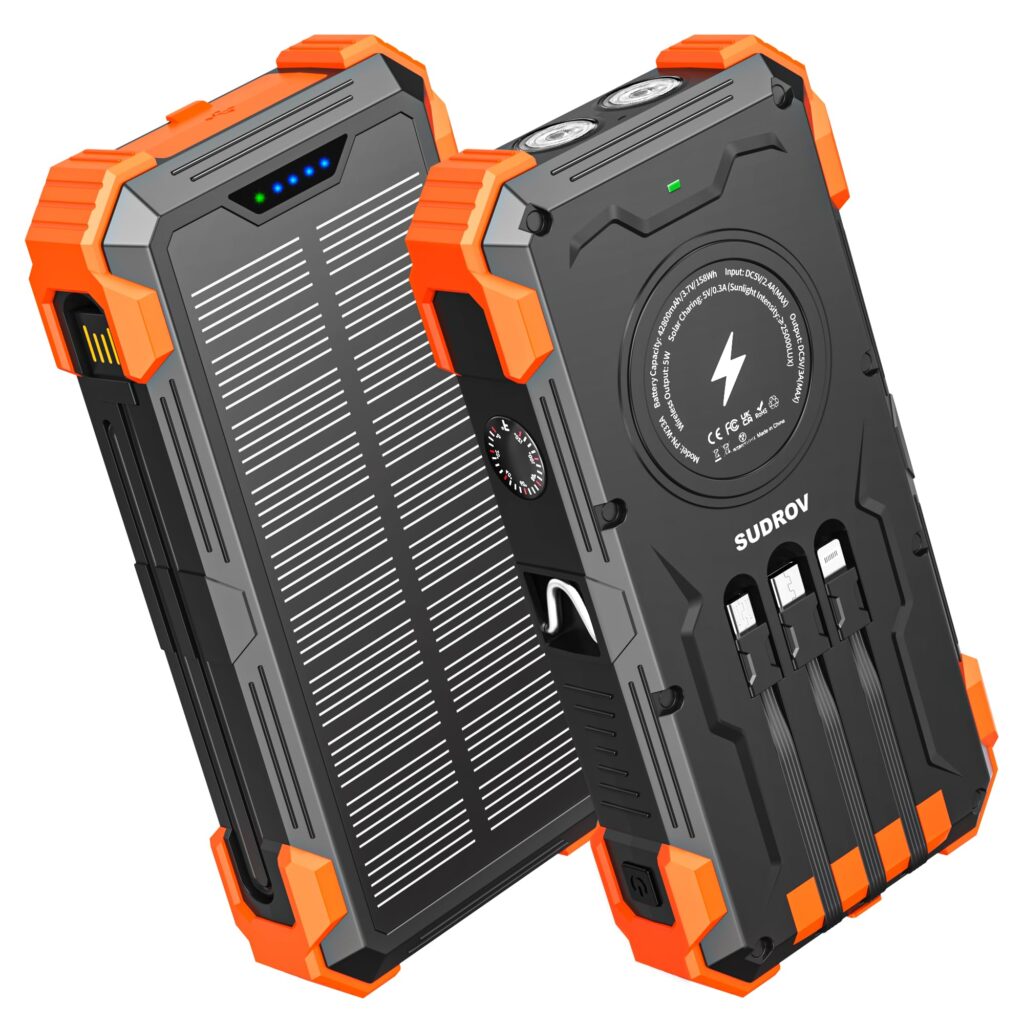
If you want a solar charger that lasts long and handles multiple devices, this one from Sudrov is worth considering.
Pros
- Huge battery capacity that really lasts through long trips
- Built-in cables mean fewer cords to carry around
- Charges up to six devices at once, including wireless options
Cons
- The solar panel is slow and not very efficient on cloudy days
- It’s a bit heavy for minimalist backpackers
- Flashlight isn’t very bright or practical beyond emergencies
We found the 42,800mAh battery impressive; it easily kept several devices powered during multi-day trips without needing a wall outlet. Having built-in cables for USB-C, Lightning, and Micro USB saved space in our packs and frustration from forgotten cords.
Charging six devices simultaneously, including via wireless charging, was a lifesaver when sharing the power bank with friends. The solar aspect worked okay but charging speed in sunlight was slow and unreliable.
The rugged design and extra features like the SOS flashlight and thermometer give peace of mind outdoors but the added weight might not suit all backpackers.
BigBlue 28W Solar Charger
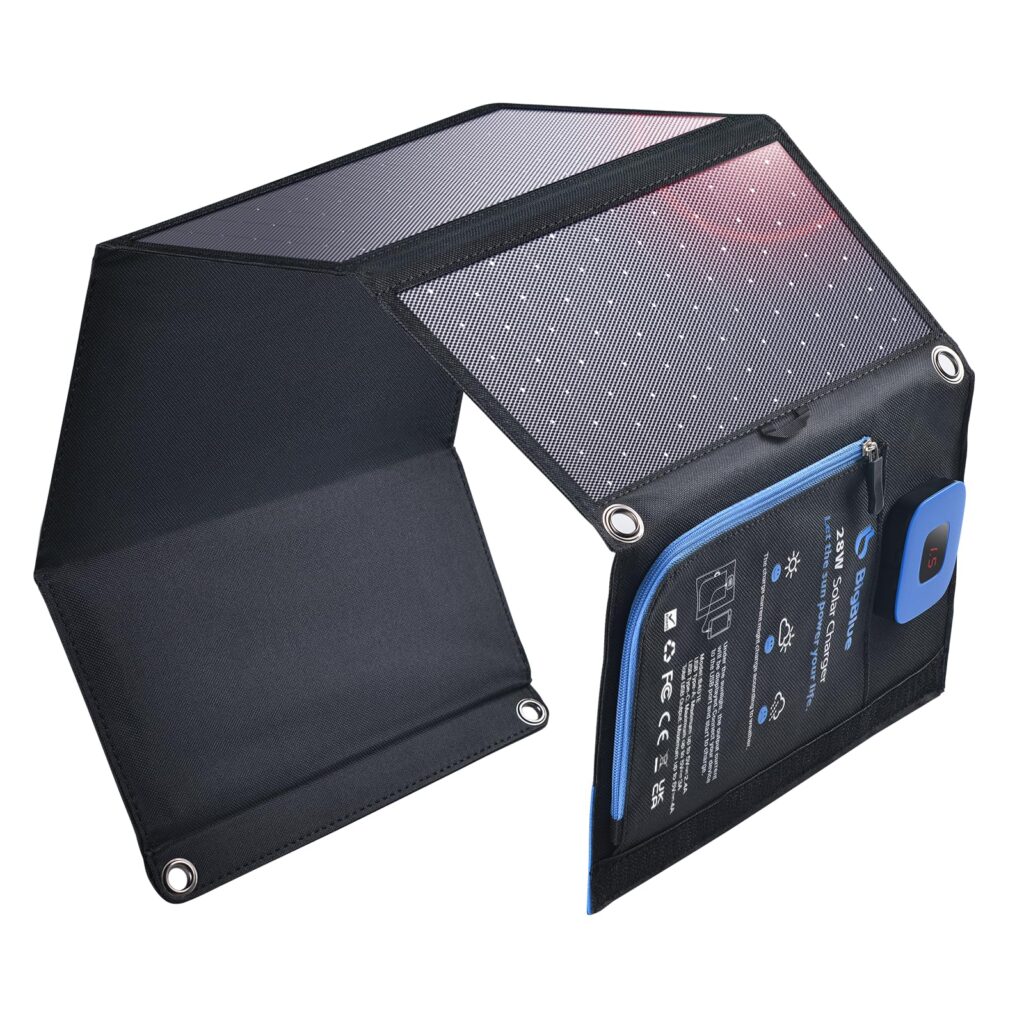
We found this solar charger perfect for backpacking trips thanks to its solid charging speed and lightweight design.
Pros
- Charges devices fast under good sunlight
- Lightweight and folds compactly for easy carry
- Waterproof fabric keeps it safe in light rain
Cons
- Carabiners provided don’t fit the mounting holes well
- Doesn’t store power, only charges devices in real-time
- USB ports need to stay dry, limiting use in wet weather
This panel impressed us with how quickly it charges phones and power banks when the sun is strong. The digital ammeter helps us see energy output in real-time, which is a nice touch during hikes.
Its foldable setup and included carabiners make it easy to attach to our backpacks or tents, though we had to swap out the carabiners for better fitting ones. The overall weight is light enough to carry all day without hassle.
Though the panel is weather-resistant, the need to keep ports dry was a bit challenging during our damp mornings. Since this charger doesn’t store energy, you need to have your device connected and in the sun to get a charge.
ERRBBIC Solar Charger
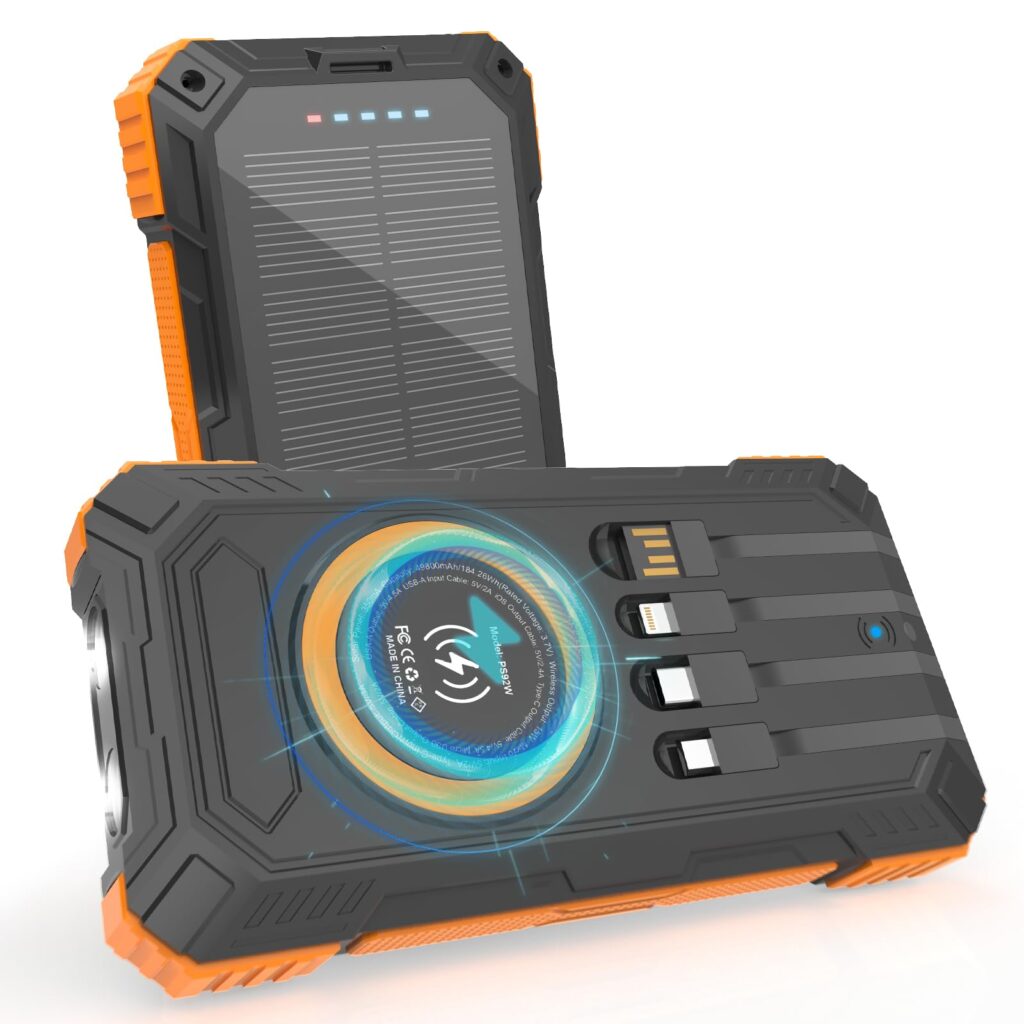
If you’re after a rugged solar charger that can power multiple devices on a long backpacking trip, this one ticks most of the boxes.
Pros
- Massive battery capacity that lasts through multiple device charges
- Built-in cables cover almost every charging port you’ll need
- Durable design with water and shock resistance for tough outdoor use
Cons
- Solar panel charges slowly, so it’s better as a backup than a primary power source
- At over a pound, it adds noticeable weight to your pack
- Wireless charging is handy but slower than wired options
We took this solar charger on a week-long trek and appreciated how the built-in cables saved space and hassle. Being able to charge an iPhone multiple times without worrying about power was a big relief.
The rugged casing stood up well to rain and accidental drops, which gave us confidence in rough conditions. Although the solar panel works in a pinch, we found it best to recharge from an outlet beforehand.
The added pound of weight is worth it if you need the high capacity, but it’s a consideration for minimalist backpackers. Wireless charging felt slow but was convenient to top off devices without digging out cables.
Buying Guide
When we look for a solar charger for backpacking, there are a few key things to keep in mind. First, portability is huge.
We need something lightweight and compact, so it won’t weigh us down or take up too much space.
Next, charging speed matters. We want panels that can turn sunlight into power efficiently, especially when clouds are in the way or daylight is limited.
More watts usually means faster charging.
Durability is a must. Our charger should handle drops, rain, and rough outdoor conditions without breaking.
Water resistance and strong casing help with that.
Let’s check how compatible the charger is with our devices. We’d want multiple output options like USB or USB-C to keep phones, cameras, or power banks charged.
Finally, consider how easy it is to set up and use. Foldable panels with hooks or magnets make a difference on the trail for attaching to backpacks or tents.
| Feature | What to Look For | Why It Matters |
|---|---|---|
| Portability | Lightweight, foldable | Easy to carry and pack |
| Charging Speed | Wattage (10W+) | Quick charging, even in low light |
| Durability | Water-resistant, rugged design | Withstands outdoor elements |
| Compatibility | Multiple outputs (USB, USB-C) | Charges various devices |
| Usability | Foldable, easy to attach | Convenient setup and use on trail |
Frequently Asked Questions
What’s the lightest solar charger that’ll actually give my gear a decent juice-up?
For light weight and decent output, look for foldable panel chargers around 100-150 grams with at least 10-15 watts.
These often charge phones and small devices reliably without adding much bulk.
Can you recommend a solar charger that’s super durable for those rough trails?
Solar chargers with reinforced fabric and shock-absorbing edges tend to last on rough trails.
Brands using ballistic nylon or TPU coatings usually hold up well after drops and scrapes.
How about weatherproof solar chargers? Any good ones that can handle rain or a dunk in a stream?
Look for chargers rated IP65 or higher for protection against water spray and brief submersion.
Some models also use water-resistant casings and sealed ports to keep moisture out.
I need lots of power. Which solar charger has the best capacity for longer trips?
Solar chargers with built-in power banks of 20,000mAh or more deliver the highest capacity.
Pair them with multiple panels to charge phones, tablets, and sometimes even laptops.
Are there any solar chargers out there with fast charging times for when I’m on the go?
Models supporting Quick Charge or USB-C Power Delivery give noticeably faster recharge times.
Those can top up compatible devices in half the time of standard USB ports.
Got any tips for solar chargers that come with cool features like built-in batteries or multiple ports?
We like chargers with integrated batteries to store power for use after sunset.
Multiple USB ports or USB-C allow charging several devices at once. This is handy on group trips.



